|
||
|
![]()
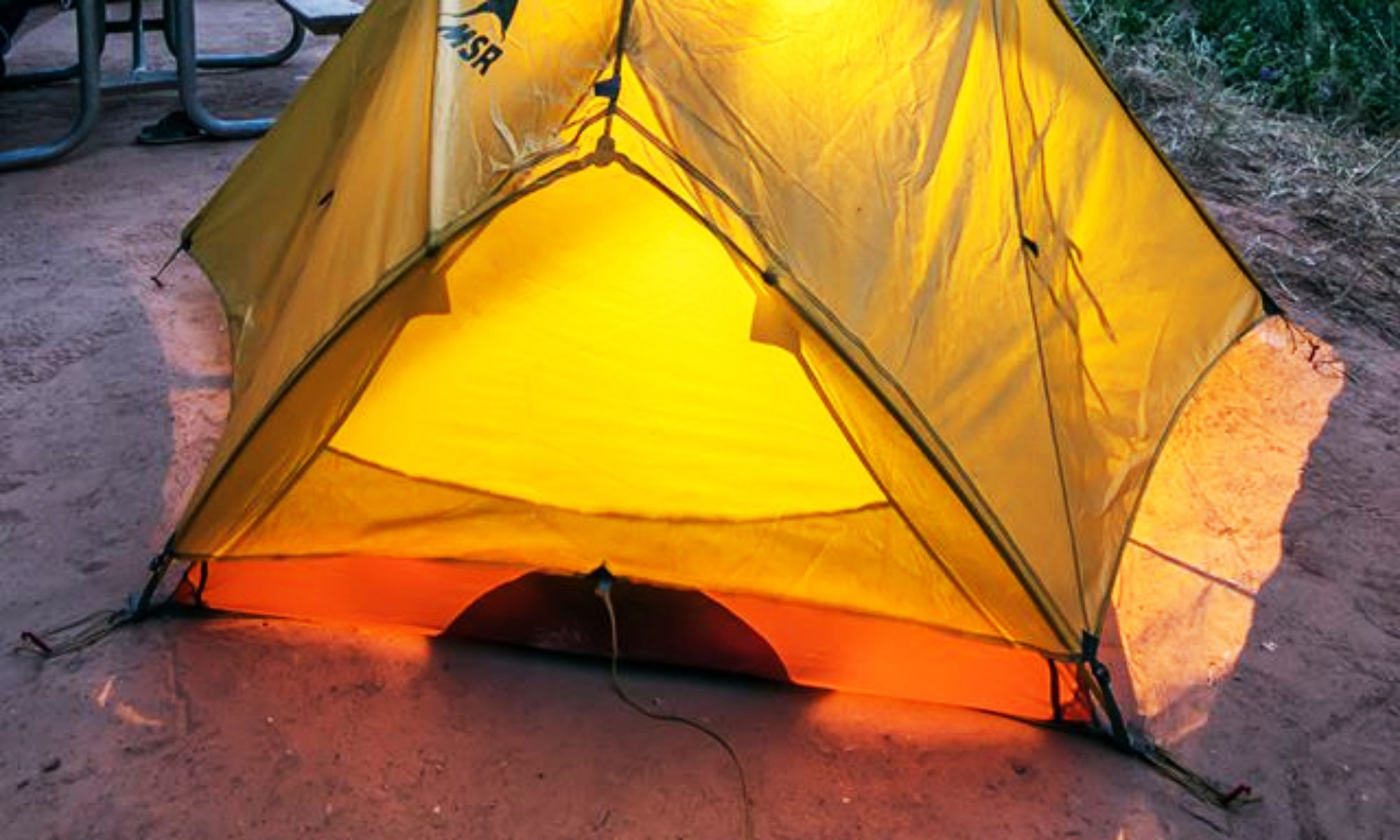
A BACKPACKERS GUIDE including popular USA Destinations
|
||
|
![]()
Are you armchair backpacking right about now? A time of Reflection. A time of Dreaming. What is your next adventure for 2020?
You are an avid Backpacker!…..but have your ever Yakpacked?
Come dream on a sunrise that can’t be beat. You already have the necessary skills, and most of the necessary gear. You can rent what you need if you don’t have a canoe or kayak.
Click this link for the full article YAKPACKING the Colorado.
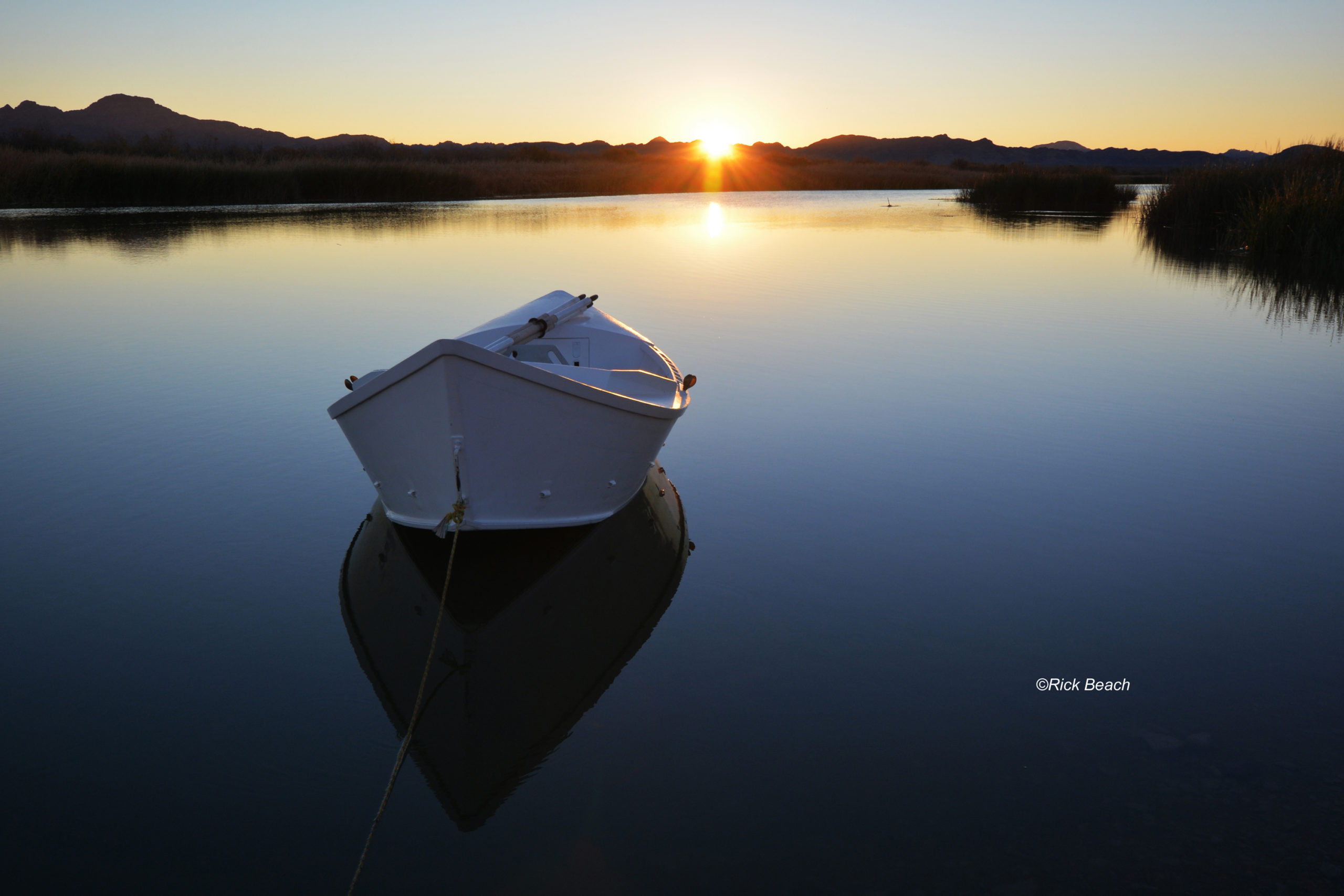
![]()
We are seeking member/reader brief Stories, Photos, Videos, & information. Anything to help out your fellow/gal backpacker or hiker. We are specifically looking for Grand Canyon Trail info. Access from the South Rim Area.
Email to: Info@Toponautic.com
Click this link to see See our teaser article.
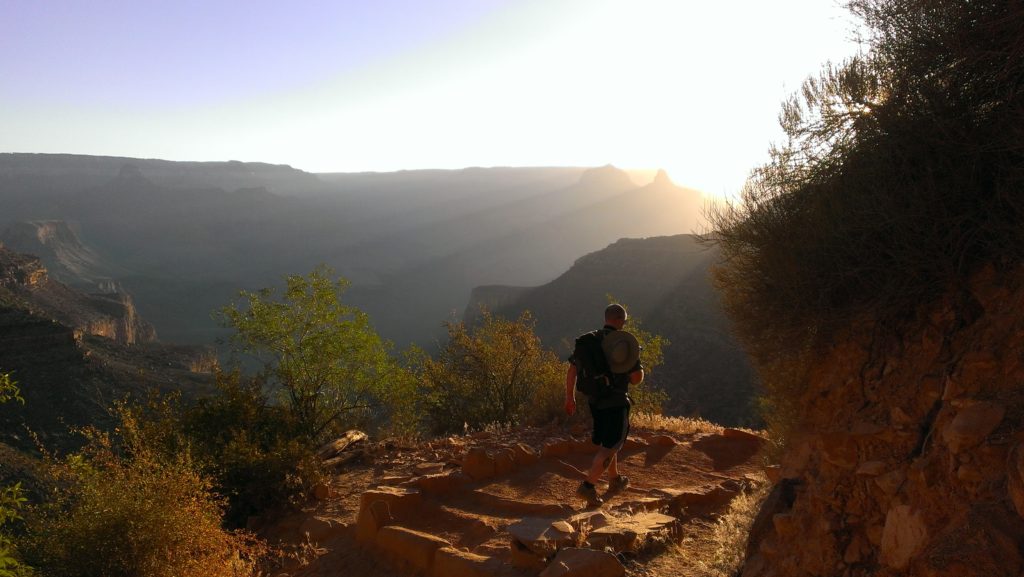
![]()
This is more of a short story from an adventure some years ago. Often found under the Title of “The Wrong Place at the Right Time”.
Within the story there are lessons to learn. The hazards of solo backpacking. Mistakes in preparation. Going pack heavy. Admitting things have gone wrong and the need too abandon original objectives.
Click this link for the full story on a “Pacific Crest Trail” adventure.
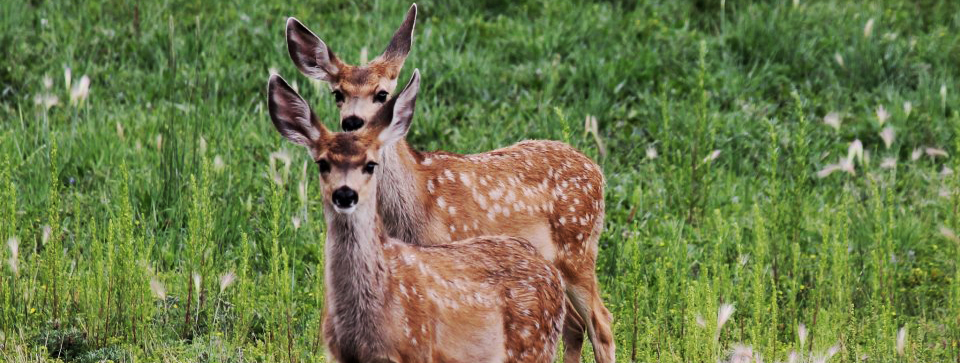
![]()
Those hardy souls that made the treks in northern Arizona around February 19 through 22, 2019 braved some serious weather. Two lane roads, as well as Interstate highways, shut down due to record breaking snow fall.
Not one person recommended taking skis…..LOL!
If you have your own photo(s) to share, please follow over to the article for more info. We would love to add them to those we are receiving. Some will make it on the website!
Click this link to see the article on Winter Conditions
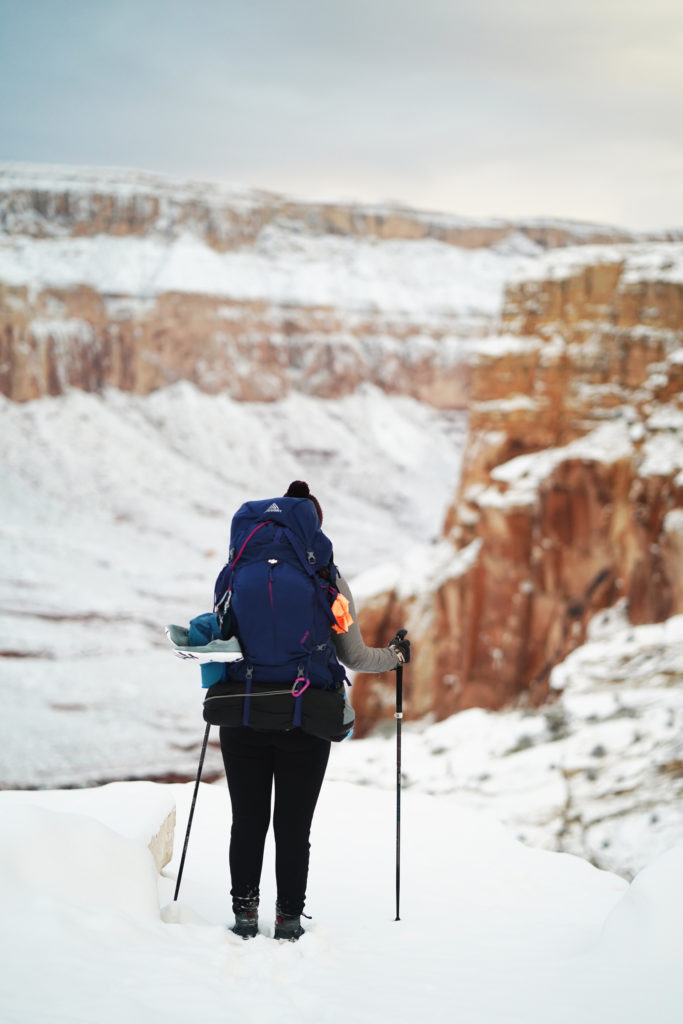
![]()
This post focuses on Cold Weather Backpacking. The general thoughts on this subject spans just about any backpacking trip where you might encounter temperatures below 30°F.
The point is…..be prepared!
Click Link for the full article on Cold Weather Backpacking.

![]()
Backpacking Northern Arizona this time of year, backpackers often experience cold weather. Especially the night time temperatures.
Click here for more on COLD WEATHER BACKPACKING info.
The past few days, and it appears for the coming week or so. The Havasu Falls area may experience night time temperatures dropping into the low teens (Fahrenheit). This is unusually cold. Day time highs will struggle to make it higher than the upper thirties. (Fahrenheit).

People in Las Vegas and closer area’s are reporting lower than normal temperatures. Las Vegas is looking at temperatures in the mid twenties (Fahrenheit) at night.
While these temperatures are “business as usual” for many winter backpackers. Such conditions for someone ill prepared or inexperienced, can really present some danger.
Such conditions require quality gear, high calorie foods & snacks, and the ability to stay dry and keep warm. This includes keeping your feet, hands, face, and head warm. Day and night!
It is advised you don’t start this trek taking a light-hearted approach. Not in these conditions. If you think your gear may be inadequate. It probably will be. Make sure you know what you are getting into. Make sure you know what you are doing. What might be a minor discomfort during normal weather, may have serious consequences if you are not prepared.
Know the signs of hypothermia. Don’t be afraid to admit to yourself or to those in your group you have a problem. If someone in your group is having symptoms. You need to help them. Get them warmed up. Even drinking warmed water will help. Check on people that complain they are cold.
If for some reason you fall in the water with your clothes on, during really cold temperatures. You need to get the wet clothes off. Get dry, and warm up as soon as possible.
In a group atmosphere encourage others to be open about voicing concerns they may be getting into trouble. Then act in such a fashion everyone is OK. Remember your gear might be better than the gear your co-backpackers have. That includes clothing and footwear. Don’t judge someone else on how comfortable you may feel.
If you feel you are in a situation that could go from bad to worse. Start hiking to your vehicle. Walk at a good pace to warm up and keep warm. Walk steady and don’t stop until you have made it safely to your vehicle. You can always return and do this trip another time.
Signs and Symptoms of Hypothermia
Stage 1
Mild
Awake and Shivering
Possible increased urine production and mental confusion
Stage 2
Moderate
Drowsy and not Shivering
Mental confusion, Slurred speech, loss of fine motor skills
Paradoxical undressing
Stage 3
Severe
Not shivering
Mental confusion, decreased or increased heart rate, decrease in breathing rate
Paradoxical undressing
Unconscious
Stage 4
Profound
No Vital Signs
NOTE: Paradoxical undressing: As a person becomes disoriented, confused, and combative. They may begin discarding their clothing. Further increasing body heat loss.
![]()
[9/28/2018] The below info has a status change. As of Friday September 28, 2018 the Narrows, Top Down permits are again being issued. An agreement was reached with a landowner, to resolve the conflict.
___________________________
[9/25/2018] Reports started flowing in 9/25/2018 that Zion National Park has suspended issuing permits to the “Narrows” area, including the popular “Top-Down” trips.
This is due to a dispute over Private Property rights.
Day hiking from the Temple of Sinawava to Big Spring is open. Upstream travel beyond Big Spring is prohibited.
We haven’t heard what has triggered this. It is a reminder to respect the land, and the locals at all times, no matter where you travel. You never know what might make someone decide to no longer share.
Here is a Link to the official Zion NP website.
https://www.nps.gov/zion/planyourvisit/thenarrows.htm
![]()
This is written for venturing into the Havasu Falls area of Arizona, USA. But much of this subject applies to backpacking anywhere. You need to know the specific wildlife of the area you intend to visit.
A sure sign of a rookie backpacker/tent camper is leaving food or smelly things like soap products, toothpaste , etc in their tent. Critters of all sorts will destroy your gear trying to get to it. The Havasu Falls area campground is well known for this problem.
If you make this error in bear country you most likely will have a lasting memory. A memory that might be terrifying? Or result in a total loss of food or gear. If you are in bear country you best have an approved container. Even then you better hang it well away from your tent and sleeping area, and practice a leave no trace campsite.
Many of these general precautions apply just about any place you backpack.
This includes packs and sleeping bags. Anything left on the ground or simply hung on a tree. Anything with a “Smell” no matter how well sealed or even unopened. It all needs to be removed from your gear when unattended or when your are sleeping. Then other prevent measures taken.
Although you may not be in bear country when visiting Havasu Falls. There are numerous critters at this specific location, that have had generations worth of training. All due to visitors not practicing food storage protection. A variety of critters are expert at chewing through gear.
A Ratsack or other food protection method is often a necessity. Just a good habit to always follow. There are a variety of critters lurking, waiting to snack on what you transport in. We have hit all seasons. From blistering summer heat, to bone chilling times of the year with snow. We have found all seasons have critters looking for easy food pickings. Namely your backpacked food.
We have hit all seasons. From blistering summer heat, to bone chilling times of the year with snow. We have found all seasons have critters looking for easy food pickings. Namely your backpacked food.
While the squirrels are the most prevalent and most destructive. There are also ring tailed cats (similar to a raccoon), actual raccoons, skunks, mice, rats, roaming horses, coyotes, various undomesticated cat breeds, and even dogs. Other areas come with their own specific critters.
While all times of the year have their hazards, the warmer months see the highest activity.
You want to protect your tent, packs, and sleeping bags from damage. While in your campsite, keep all food and smelly items such as toothpaste, soap, cosmetics, lip balms, etc out of your tent, sleeping bags, and packs that are left unattended. Forget for even 5 minutes and it may be too late.
They will chew through tents (the rodents), drag your pack away (ring tails, racoons and canine breeds), and trash your tent (horses).
The first line of defense is to get your food and toiletries away from your expensive gear. Keep those items from leaving lingering smells on your gear too.
Our most successful method of prevention so far for the rodent type, is to purchase a Ratsack, Then stash/hang your “stuff”. Use a length of 100lb test mono-filament fishing line over a high tree branch. Hoist up the sack high enough. Keep in mind some larger animals will stand on their hind legs to reach up and try to snatch goodies. The horses even are adept on their hind legs. If it is hung close to the trunk or branch many of the small creatures can jump an incredible distance.
All of our items are first put in ziplock freezer bags. Even our “Pack it out Trash” is ziplock bagged and kept in your Ratsack too.
We ordered our “Ratsack”off Amazon. Only the large size was available at the time. When it arrived it looked overly large. It probably is too large for a single person. In hindsight I am glad that was the one we purchased. For two people it is very ample. We hadn’t thought through the trash issue until we were actually on the first trip with it. Then we were glad for the larger ratsack. We had plenty of room for both food and trash, times 2 people, for a 3 night backpacking trip. But it might be gross to some to mix good and trash together?
Bear proof containers are another option. Though Bears are not a worry in this Havasu Falls area. If you have such a container, and don’t mind the additional weight, they are doable. I would opt for the Ratsack in lieu of the Bear proof container in areas that I can do that. I have both to pick from. Its all about weight, and the critters you might run up against.
Keeping with Leave No Trace. Whatever you bring to hang your food. Containers, string, rope, or what have you. Be sure to take it down and pack it out when you hike out. Don’t leave any of it behind for the “next person”. You may want a second Ratsack to contain your opened product wrappers, leftovers, and waste you need to pack out?
![]()
This collective of Footwear recommendations is by numerous experienced backpackers that have provided input. Backpacking not only this area, but backpacking in general, anywhere.
We will discuss Footwear, Socks, Toenails, and Water Shoes. Especially for this trip, this terrain, and for safety reasons that many choose to ignore.
Many ignore functionality for the sake of looking ‘cool’ or “rad’, or whatever your generational lingo might be.
If you have something that needs added please email us with your thoughts.
IT’S ALL ABOUT THE FOOTWEAR
The type of boot or footwear you hit this trail with, will probably be your most important decision concerning gear.
Many people attempting a trip may have never done long distant hiking, let alone Backpacking under a load. Also not in such terrain.
Hiking and backpacking are two different worlds. We aren’t providing info for those that wimp out and have their gear transported by animal or vehicle.. Or for those that have their gear transported due to some special need due to medical or physical issues.
This info is for those that will truly be strapping all their gear on their back and hoofing it down the trail.
Many have hauled their own gear while backpacking. Then decide, there is no way they are carrying it back out.
The terrain and climate on any trip can be a challenge to many even without a pack. Add to these facts, the majority of people tend to carry a pack that is way over weight. Especially first timers. Many people are also not in peak physical condition.
There are many brands of footwear out there. It all boils down to personal choice, fit, and what you can afford. This is one item that really falls in the category of “You get what you pay for”. Don’t go cheap (Cheap in terms of poor quality) just because you think you will only use them for this one trip.
Don’t be swayed by recommendations that just don’t make sense for the terrain, pack weight, distance, weather (cold/wet) etc.
There is a reason Military personnel worldwide wear boots. The type that protects the ankles, provides sole protection, and arch support….. to repeat some of the reasoning. Not tennis shoes, or trail runners, etc.
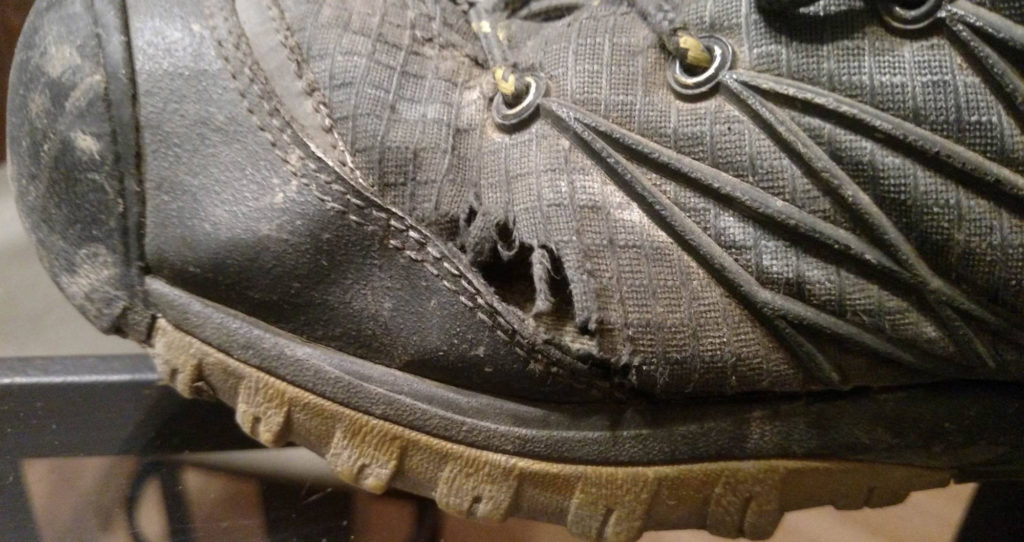
Wearing proper, properly fitted,and properly broke in footwear will prevent a multitude of foot and ankle pain, and injuries.
Properly fitted also means making allowances for feet swelling or spreading, when hiking long distances, or under backpacks loads.
Breaking your footwear in is a must!
You won’t need many of the foot blister products that people recommend to make up for not heeding this simple step.
The majority of new people will unfortunately not listen to this advice, then end up learning some hard and painful lessons. But experience is a wonderful teacher.
Substantial soles are recommended to protect the bottom of your foot. A thousand steps on poor soles is like beating your feet over many hours. Walking on stones especially under load, with inadequate soles can cause long term pain that can last well beyond your trip.
Over the ankle footwear is better when used while backpacking under load or used to walk in rough terrain. It provides added support to prevent sprains. It is also highly recommended when cold and rainy.
The terrain can often cause you to misstep and twist or sprain an ankle.
Wearing low cut shoes can raise the chance of injury. Going down with a pack strapped on can cause broken arms, fingers, wrists, and the list goes on.
When backpacking under a load your foot tends to spread out and swell to some degree. Many of us have found boot styles that compensate for this. I personally recommend Keen’s brand after trying many brands over the years. They provide ample toe room .
When being fitted you want to take the socks you will hike with. Have the boots professionally fitted. Don’t just grab a pair of cheap boots off a discount rack, in your size, and head out the door for home…or worst out on the trail. They also need broke in!
Higher boots are recommended during the cold weather months. Especially when there is a chance of rain. Waterproof even better.
This brings up the point of using waterproof over the ankle boots when it is wet and cold. We are talking temperatures in the teens through the upper thirty degree Fahrenheit temps. You may even want to consider “Gaiters” and rain pants over those, to prevent rain or splashed water from running into the tops of your footwear.
You won’t stand a chance with low cut footwear in the wet and cold. If you can tolerate wet feet at 30°F or lower, then go for it.
Closed toe footwear is highly recommended. Seasoned backpackers consider it a “must”. There will always be those that will brag they backpacked in sandals, flip-flops, or tennis shoes. That they find them comfortable and the way to go. If you are new to this, don’t gravitate to this mentality. Rest assured, there are many testimonials of people having extreme pain and long lasting injuries. Inadequate types of footwear can be hazardous backpacking or even hiking.
Blisters seem to be the biggest problem.
Some that become incapacitated can ruin a trip for an entire group. A group of friends that may have spent months if not years waiting and planning for a trip. This is no longer an inexpensive trip either. Fee’s have been jumping each year.
Many ignore the recommendation of bottom soles rated for backpacking. Or ankle support to avoid twisting an ankle.
Some people will blow off experienced people recommending shoes/boots rugged enough, and made specifically for backpacking.
Proper footwear may also prevent knee and back injuries, or the unfortunate accident of going down with the weight of your pack on you. As said earlier, such a fall can result in finger, wrist, arm fractures, and damaged knees.
We even have a story from an acquaintance that went down. Hard enough to result in a broken nose.
Full protection footwear with socks is recommended. Both for protection from sharp objects, and to prevent sand and small stones rubbing your skin.
Open toes shoes are famous for getting a person stuck in the toe by thorns, cactus needles, pine needles, twigs, or some other pointed object.
It’s an invitation to peel off a toenail. Or worse, catch a toe and break it.
With punctures you would have to be concerned with tetanus or other types of infection. Or run something sharp up under your toenail. The coyotes will come running to your howling!
This is the same reason seasoned deck hands on boats wear closed toe footwear. They have the learned knowledge concerning similar hazards such as catching a toe on a deck cleat or other hardware.
Open footwear has a tendency to load up with sand or sharp small pebbles. All of which act like sandpaper on your tender feet.
There are endless rookies out there that have been lucky. People that pay no heed, and haven’t had an accident happen yet. They suggest or even brag they backpacked in sandals or other inadequate footwear.
This is the same mentality as not wearing a seat belt in a car because of never having a crash yet. People wouldn’t have accidents if they could see what the next few minutes of life had approaching.
You are pretty much on your own in a remote area. Leaving pain and suffering out of the equation, it is real inconvenient and expensive to seek any type of emergency medical attention.
Should you be injured, you will more than likely have to do considerable hiking with serious pain.
Helicopter medi-vac….I can’t even image what that would cost someone. We have heard $20K to $40K….and that is on your dime.
Don’t be that rookie that ends up suffering to save a few dollars, believing what some say of hiking with the lesser.
Or not heeding those with the life long experience that have contributed to this collective of recommendations.
If you aren’t concerned about yourself, at least be concerned about wrecking the trip for others that may be traveling with you.
ENJOY YOUR TRIP – SUMMARIZING
I am sure you will pass some ill prepared people that are doing a hike in everything from tennis shoes to flip-flops. I have seen them limping too.
Backpack smart, enjoy the trip, and don’t ruin it for someone else that is traveling with you. It is too hard to get permits into this area. You want a trip you can brag about. Not one you complain about.
Break the boots in long before you ever do long distance hikes or backpacking. Try them out soon after purchase. Wear them around the house, to go shopping, etc. If they don’t feel right take them back while you still can.
Eventually work up to walking several miles in your boots. Then start hauling around some weight in a backpack to prep for your actual hike. Somewhere in your planning and prepping stage you need to be doing several conditioning hikes that are the equivalent of your longest day backpacking leg.
Don’t do a trip cold turkey with no conditioning. Again some macho types will have you believing going cold turkey is possible with no pain. When you wake up the next morning after your hike with a backpack, you will know what some of us are talking about. Hiking/Backpacking down, and uphill works muscles you don’t normally work when traveling on flat terrain.
Include some inclines or stair steps in your conditioning.
The secondary benefit of breaking in your footwear, and conditioning with weight, distance, and incline, is the fact you will be toughing up the skin on your feet. This especially benefits people not accustomed to long distance backpacking. We aren’t talking about building up any super layer of callus. But those that put in miles constantly, have definitely built up hardened skin that provides a huge protection factor. These people fair much better than those with soft feet.
![]()